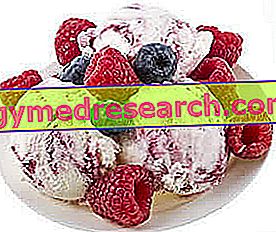Although they are important for the preparation of cream, cream and sometimes even fruit ice creams, fats are not so indispensable (as sugars are).

Fats - like all the other components of the mixture - must be added in precise quantities: an excess of fat in the mixture would produce an excessively oily, cloying and heavy ice cream, while a deficiency could make the ice cream lacking in body (especially in cream ice creams). In general, fats should be used in a percentage between 6 and 10% (of the weight of the mixture).
Fats are mainly found in the following ingredients:
- MILK : with the term "milk", reference is made only to cow's milk, obtained from the complete and uninterrupted milking of animals in good health and nutrition . And it is precisely that of cow the milk most used to prepare "yellow base" (egg) and "white base" (without egg) ice creams. The milk coming from other types of mammals does not have a particular interest in the production of homemade ice cream. Due to the richness of its constituents, milk is considered a complete food, capable of raising the nutritional value of ice cream. Like all the components of an ice cream, milk must also be handled (and chosen) with care, in full compliance with hygiene standards. In the ice cream parlor you can use different types of milk, based on the final product you intend to make: whole milk, semi-skimmed milk, whole milk powder, skimmed milk powder, condensed milk (sweetened or not).
The table shows the various types of milk used in gelato making; the average nutritional values of each type are also specified.
| Type of milk | Fat% | Sugars % | Protein% | Mineral salts, vitamins% | Water % |
| Whole cow's milk | 3.5-3.6 | 4.5-4.9 | 3.3-3.5 | 9.0 | 87.5 |
| Whole powdered milk | 24.9-27.0 | 38.0-42.0 | 26.0-28.0 | 6.0 | 3.0-3.2 |
| Skim milk powder | 0.7-0.9 | 51.5-56.2 | 33.1-37.0 | 8.3 | 3.0-5.0 |
| Sweetened condensed milk | 9 | 56.5 | 9.0-11.0 | 8.7 | 26.5 |
- CREAM : in ice cream, the cream is considered the "queen" of cream ice creams for its delicate flavor and for its excellent upright capacity. Generally, to make an ice cream mixture, we tend to prefer fresh cream, which provides about 35% fat. To contain calories, it is still possible to use less caloric cream, such as cooking cream (20% fat).
| Type of milk | Fat% | Sugars % | Protein% | Mineral salts, vitamins% | Water % |
| Fresh cream | 35 | 2.3 | 2.4 | 0.3 | 60 |
| Cooking cream | 20 | 3.9 | 2.8 | 0.3 | 72 |
- EGG (egg yolk) : if, in cream ice creams, milk is the major water-bearer and sugar helps to give sweetness and body to ice cream, the egg is considered an excellent thickening, emulsifying, mounting and structuring agent. In the past, the egg could not be missing in the formulation of ice creams because it is considered an essential emulsifying ingredient, able to "bind" water to the fats contained in the mixture. With the improvement of the art of ice cream making, the egg (or rather, the egg yolk) was partially or totally replaced by the mono / diglycerides of fatty acids for a series of hygienic, cost and efficiency reasons. Many modern artisan gelato makers, however, are extensively re-evaluating the presence of the egg in the production of quality ice creams, not only for the known emulsifying and binding properties, but also for the probable moderately anti-freezing capacities attributed to the proteins contained in the yolk. In fact, a mixture for ice cream enriched with egg tends to freeze at lower temperatures compared to another mixture, equally formulated but without egg.
It has also been discovered that the appropriate heating of the mixture is an indispensable operation to fully exploit the emulsifying, binder and thickener capacities of egg proteins for making ice cream.
Warning!
An excess of eggs in the mixture can modulate the flavor of the ice cream in a negative sense, concealing the other ingredients. Furthermore, too many eggs can cause the formation of foam during the ice-cream defrosting phase.
- FLAVORED PASTA : there are different types of flavoring pastes on the market, such as hazelnut, cocoa or pistachio paste. These are concentrated noble pastes able to speed up the ice cream maker's work, thus obtaining quality ice creams in a short time. Even the noble pastes must be properly balanced before preparing the mixture: each flavoring paste, in fact, stands out for its own content of sugars and fats.
- BUTTER (animal fat) and MARGARINE (vegetable fat): butter is an ideal fat for the preparation of full-bodied and relatively heavy ice cream. However, the tendency to go rancid and the non-negligible cost limit the use of butter to some special artisanal gelato. The butter, which undoubtedly weighs down the ice cream mixture, is sometimes replaced by hydrogenated vegetable fats, which can be more easily preserved. Butter and margarines - like all the other fats in the mix - must be properly balanced to obtain a product with an optimal taste and structure: an excess of fat in the ice cream, in fact, can disturb the palatability of the product and lower the overrun (amount of air incorporated in the mixture during the freezing stage of the ice cream).
Chocolate Ice Cream Without Eggs
X Problems with video playback? Reload from YouTube Go to Video Page Go to Video Recipes Section Watch the video on youtube



